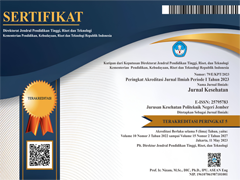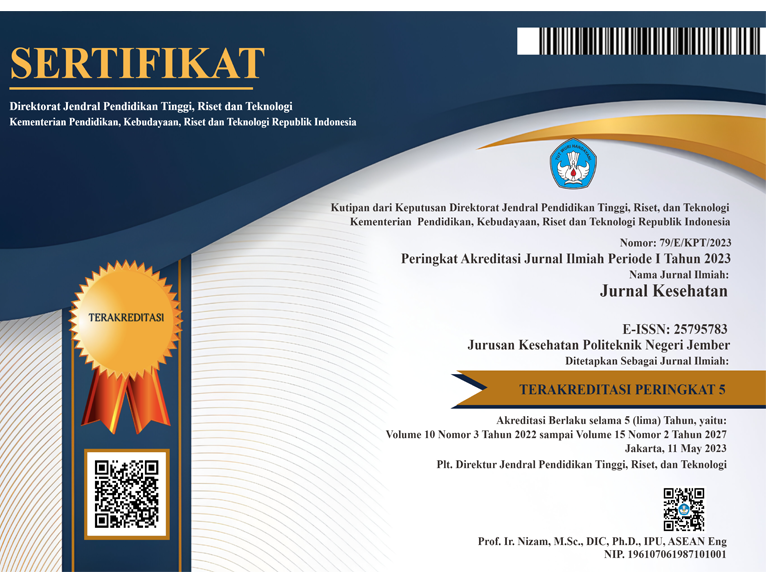Keluhan Carpal Tunnel Syndrome pada Pekerja Sortasi Daun Tembakau (Studi di Gudang Restu I Koperasi Agrobisnis Tarutama Nusantara Jember)
DOI:
10.25047/j-kes.v6i1.14Downloads
Abstract
Abstract
Recruitment of labor in tobacco industry at Jember is high and there are still many utilize manual labor. Manual labor can increase complaints from workers.There are several MSDs listed in ILO, one of which is Carpal Tunnel Syndrome (CTS). CTS can cause pain and limit the function of the wrist and hand. Sorting work is one of the jobs with a high prevalence of CTS as it requires precision and accuracy. The purpose of this research was to analyze CTS complains on leaf sorting workers in Restu I warehouse of Agribusiness Tarutama Nusantara Cooperative.This was a descriptive research with quantitative approach. The results indicates that majority of leaf tobacco leaf workers (81,7%) in Restu I Warehouse experienced CTS complaint. Respondents with age more than 40 years are 3,609 times at risk of CTS complaint. Respondents with CTS complaint were more common at age more than 40 years, who had more nutritional status categories of overweight, who had a working period of more than 4 years as tobacco leaf sorting worker at Restu I Warehouse, who had medium risk work posture, and respondents who repeat movements of the wrist more than 30 times per minute.
Keywords: MSDs, Carpal Tunnel Syndrome (CTS), Tobacco Leaf Sorting
References
American Academy of Orthopaedic Surgeons. 2008. Clinical Practice Guideline on the Treatment of Carpal Tunnel Syndrome. Rosemont: AAOS.
Ashworth, N.L. 2017. Carpal Tunnel Syndrome. http://www.emedicine.com/pmr/topic21.htm. [Diakses pada 19 November 2017].
Basuki, R., M.N. Jenie, dan Z. Fikri. 2015. Faktor Prediktor Carpal Tunnel Syndrome (CTS) pada Pengrajin Alat Tenun Bukan Mesin (ATBM). Jurnal kedokteran Unimus. 4(10): 1-7.
Demiryurek, B.E., dan A.A. Gundogdu. 2017. Prevalence of Carpal Tunnel Syndrome and Correlation with Pain among Female Hairdressers. International Journal of Occupational Medicine and Environmental Health 2018. 31(3): 1-7.
Fitriani, R.N. 2012. Faktor-Faktor yang Berhubungan dengan Dugaan Carpal Tunnel Syndrome (CTS) pada Operator Komputer Bagian Sekretariat di Inspektorat Jenderal Kementerian Pekerjaan Umum Tahun 2012. Skripsi. Jakarta: Universitas Islam Negeri Syarif Hidayatullah.
Giersiepen, K., dan M. Spallek. 2011. Carpal Tunnel Syndrome as an Occupational Disease. Deutsches Ärzteblatt International. 108(14): 238-242.
Kurniawan, B. 2008. Faktor resiko kejadiaan carpal tunnel syndrome CTS) pada wanita pemetik melati di Desa Karangcengis-Purbalingga. Skripsi. Universitas Diponegoro.
Nendah, H. 2007. Hubungan Gerakan Repetitif Berkekuatan dengan Faktor Individu dengan CTS Pada Penenun Mendong di CV Mendong Jaya Kota Tasikmalaya. Skripsi. Semarang: Fakultas Kesehatan Masyarakat Universitas Diponegoro.
NIOSH. 1997. Musculoskeletal Disorders and Workplace Factors. AS: NIOSH.
Pascarelli, E. 2004. Dr. Pascarelli’s complete guide to repetitive strain injury : what you need to know about. New Jersey: John Wiley & Sons, Inc.
Putri, I.P. 2015. Hubungan Gerakan Repitisi Dan Indeks Massa Tubuh (IMT) dengan Kejadian Carpal Tunnel Syndrome (CTS) Pada Pengrajin Batik Tulis Di Kemiling Bandar Lampung. Skripsi. Bandar Lampung: Fakultas Kedokteran Universitas Lampung.
Rohmah, S. 2016. Analisis Hubungan Faktor-Faktor Individu dengan Carpal Tunnel Syndrome (CTS) pada Pekerja Konveksi. https://publikasiilmiah.ums.ac.id/handle/11617/7064. [Diakses pada 28 Oktober 2017]
Salawati, L., dan Syahrul. 2014. Carpal Tunel Syndrome. Jurnal Kedokteran Syiah Kuala. 14(1): 29-37.
Sekarsari, D., A.D. Pratiwi, dan A. Farzan. 2017. Hubungan Lama Kerja, Gerakan Repetitif Dan Postur Janggal Pada Tangan Dengan Keluhan Carpal Tunnel Syndrome Moramo Utara Kabupaten Konawe Selatan Tahun 2016. Jurnal Ilmiah Mahasiswa Kesehatan Masyarakat. 2(6): 1-9.
Setiawan, M.A.D., I.M.N. Winaya, dan I.M. Muliarta. 2016. Hubungan Postur Pergelangan Tangan Saat Mengetik Terhadap Risiko Terjadinya Carpal Tunnel Syndrome (CTS) Pada Karyawan PT. X. Majalah Ilmiah Fisioterapi Indonesia. 5(3): 40-43.
Tana, L., F.S. Halim, Delima, dan W. Ryadina. 2004. Carpal Tunnel Syndrome pada Pekerja Garmen di Jakarta. Buletin Penelitian Kesehatan. 32(2):73-82.
Tarwaka. 2015. Ergonomi Industri: Dasar-Dasar Pengetahuan Ergonomi dan Aplikasi di Tempat Kerja. Surakarta: Harapan Press.
Weinberg, N.P. 2000. Natural & Herbal Remedies for Carpal Tunnel Syndrome. United States: Storey Publishing LLC.
License
Authors who publish in this journal agree to the following terms:
1. Copyright belongs to the medical journal as a publication
2. The author retains copyright and grants the journal rights to the first publication carried out simultaneously under a Creative Commons Attribution License which allows others to share the work with an acknowledgment of the author's work and initial publication in this journal.
3. Authors may enter into separate additional contractual arrangements for the non-exclusive distribution of the work (eg sending it to an institutional repository or publishing it in a book) with acknowledgment of initial publication in this journal.
4. Authors are permitted and encouraged to post work online (eg in institutional repositories or on their websites) before and during the submission process, as before and larger citations of published work (see Effects of Open Access).
Selengkapnya tentang teks sumber ini














